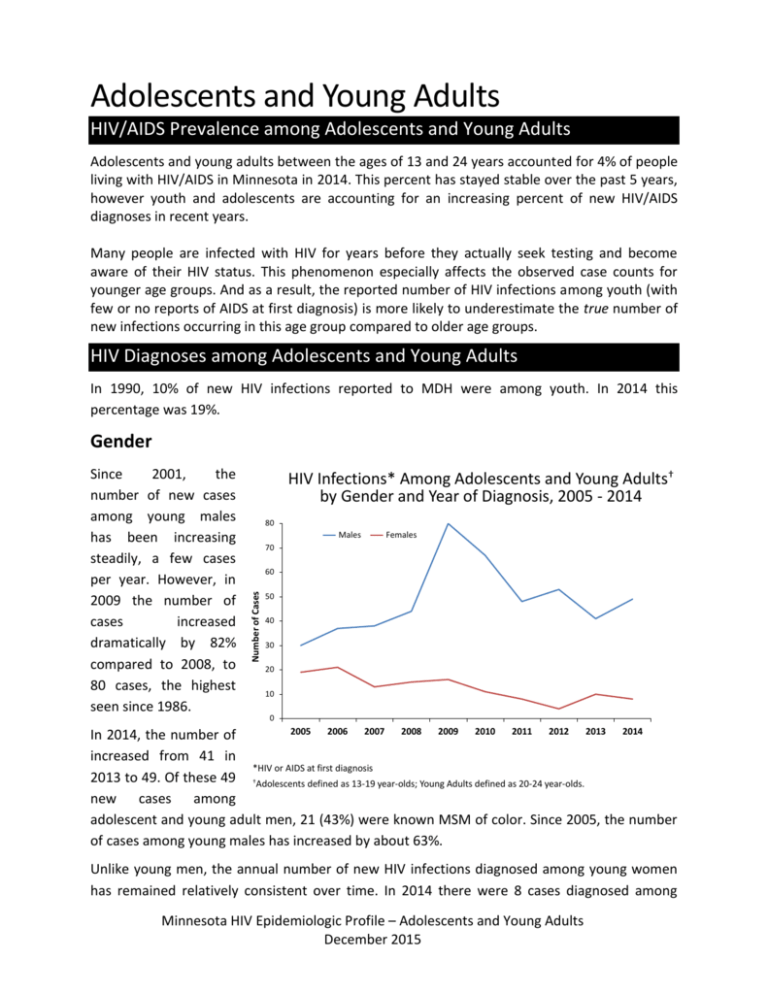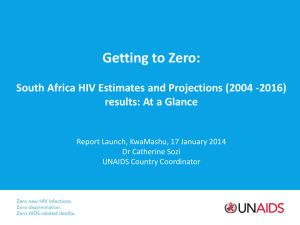MS Word - Minnesota Department of Health
advertisement

Adolescents and Young Adults HIV/AIDS Prevalence among Adolescents and Young Adults Adolescents and young adults between the ages of 13 and 24 years accounted for 4% of people living with HIV/AIDS in Minnesota in 2014. This percent has stayed stable over the past 5 years, however youth and adolescents are accounting for an increasing percent of new HIV/AIDS diagnoses in recent years. Many people are infected with HIV for years before they actually seek testing and become aware of their HIV status. This phenomenon especially affects the observed case counts for younger age groups. And as a result, the reported number of HIV infections among youth (with few or no reports of AIDS at first diagnosis) is more likely to underestimate the true number of new infections occurring in this age group compared to older age groups. HIV Diagnoses among Adolescents and Young Adults In 1990, 10% of new HIV infections reported to MDH were among youth. In 2014 this percentage was 19%. Gender HIV Infections* Among Adolescents and Young Adults† by Gender and Year of Diagnosis, 2005 - 2014 80 Males Females 70 60 Number of Cases Since 2001, the number of new cases among young males has been increasing steadily, a few cases per year. However, in 2009 the number of cases increased dramatically by 82% compared to 2008, to 80 cases, the highest seen since 1986. 50 40 30 20 10 0 2005 2006 2007 2008 2009 2010 2011 2012 2013 2014 In 2014, the number of Year increased from 41 in *HIV or AIDS at first diagnosis 2013 to 49. Of these 49 †Adolescents defined as 13-19 year-olds; Young Adults defined as 20-24 year-olds. new cases among adolescent and young adult men, 21 (43%) were known MSM of color. Since 2005, the number of cases among young males has increased by about 63%. Unlike young men, the annual number of new HIV infections diagnosed among young women has remained relatively consistent over time. In 2014 there were 8 cases diagnosed among Minnesota HIV Epidemiologic Profile – Adolescents and Young Adults December 2015 young women, this accounts for a 20% decrease from the ten cases diagnosed in 2013. Females accounted for 14% (8/57) of new HIV infections diagnosed among adolescents and young adults in 2014. Overall, young women accounted for 11% (8/73) of new infections among females and young males accounted for 21% (49/237) of new infections among males in 2014. Race/Ethnicity Similar to the overall HIV Infections* Among Adolescents and Young Adults† HIV/AIDS epidemic, people by Gender and Race/Ethnicity, 2012 - 2014 Combined of color account for a Males (n = 143) Females (n = 22) disproportionate number of new HIV infections Afr Amer 27% White among adolescents and 39% White young adults. Among 32% Hispanic young men, white men 4% accounted for 39% of new Asian/PI HIV infections diagnosed Afr Amer 1% 39% between 2012 and 2014, Other 2% African American men Afr born Afr born Other 32% Amer Ind 2% 5% accounted for 39%, and Hispanic 2% 15% Hispanic men 15%. n = Number of persons Amer Ind = American Indian American Indian, African*HIV or AIDS at first diagnosis Afr Amer = African American (Black, not African-born persons) born, and Asian/Pacific †Adolescents defined as 13-19 year-olds; Afr born = African-born (Black, African-born persons) Young Adults defined as 20-24 year-olds. Islander men made up 2%, Other = Multi-racial persons or persons with unknown race 2%, and 1% of the remaining cases, respectively. Among young women, white women accounted for 32%, African American women 27%, African-born women 32%, Hispanic women 4%, and women with multiple or unknown race accounted 5% of the new infections diagnosed during the same time period. Mode of Exposure Men having sex with men (MSM) was the predominant mode of HIV exposure among adolescent and young adult males, accounting for an estimated 93% of the new HIV infections diagnosed between 2012 and 2014, while the joint risk of MSM and injecting drug use (IDU) accounted for an estimated 4% of the cases in the same time period. Heterosexual sex accounted for an estimated 2% of cases. Heterosexual contact accounted for an estimated 94% of new HIV infections diagnosed among adolescent and young adult females between 2012 and 2014 while IDU accounted for an estimated 6%. Minnesota HIV Epidemiologic Profile – Adolescents and Young Adults December 2015 HIV Infections* Among Adolescents and Young Adults† by Gender and Estimated Exposure Group#, 2012- 2014 Males (n = 143) Females (n = 22) Heterosex 94% MSM 93% Other 1% Heterosex MSM/IDU 2% 4% IDU 6% n = Number of persons MSM = Men who have sex with men IDU = Injecting drug use Heterosex = Heterosexual contact with someone with or at risk for HIV Other = Hemophilia, transplant, transfusion, mother w/ HIV or HIV risk †Adolescents defined as 13-19 year-olds; Young Adults defined as 20-24 year-olds * HIV or AIDS at first diagnosis Treatment Cascade among Adolescents and Young Adults Although the treatment Percentage of persons 13-29 years old diagnosed with HIV cascade for young people engaged in selected stages of the continuum of care, includes people living 2014– Minnesota 100% 100% with HIV/AIDS up to age 100% 29, the general trend can 87% 90% 82% be seen for adolescents 80% 75% 72% and young adults. There 70% 63% 59% were 666 HIV positive 60% persons aged 13-29 50% 40% included in the treatment 30% cascade analyses and 101 20% cases in this age group 10% reported in 2013 that 0% were included in the Overall Cascade 13-29 year olds linkage to care PLWH Linkage to Care Retention in Care Viral Suppression calculation. Young n=7,728 n=666 people living with HIV/AIDS (aged 13-29) have lower rates of linkage to care and retention in care compared to other age groups and they also have the lowest rate of viral suppression (59%). Minnesota HIV Epidemiologic Profile – Adolescents and Young Adults December 2015




